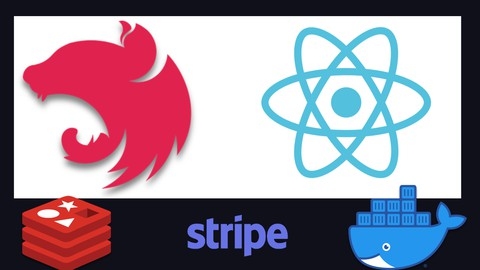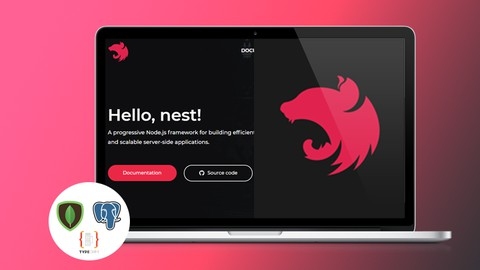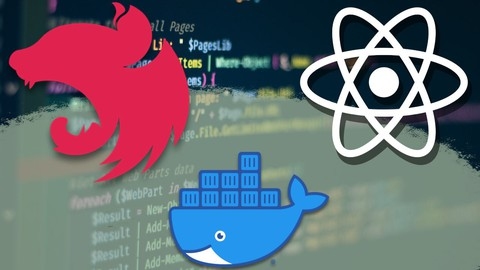NestJS is a powerful and popular framework for building scalable and maintainable backend applications using Node.js and TypeScript.
It provides a robust structure and a rich set of tools to help you create modular, well-organized, and easily testable code.
Learning NestJS can open doors to exciting career opportunities in backend development, allowing you to build modern, efficient, and reliable applications.
Finding the right NestJS course on Udemy can feel overwhelming, with so many options claiming to be the best.
You’re searching for a course that covers the fundamentals, dives into advanced concepts, and provides practical experience through real-world projects.
We’ve carefully evaluated numerous NestJS courses and have determined NestJS Zero to Hero - Modern TypeScript Back-end Development to be the best overall course available on Udemy.
This comprehensive program starts from the ground up, guiding you through setting up your development environment, building a Task Management REST API, and implementing essential features like authentication, data persistence, and testing.
The instructor provides clear explanations, practical examples, and engaging projects to ensure you master NestJS effectively.
While this is our top recommendation, we understand that everyone’s learning style and goals are unique.
We’ve compiled a detailed list of other excellent NestJS courses on Udemy to help you find the perfect fit for your journey.
So, continue reading to discover more options and choose the course that aligns with your interests and aspirations.
NestJS Zero to Hero - Modern TypeScript Back-end Development
You’ll start by setting up the development environment, installing prerequisites like Node.js, Yarn, and the NestJS CLI.
The course guides you through creating a Task Management REST API from scratch, introducing core NestJS concepts like modules, controllers, providers, and services along the way.
As you build the API, you’ll learn how to implement CRUD operations, data validation with pipes, error handling, and advanced features like searching and filtering.
The course dives deep into data persistence using PostgreSQL and TypeORM, ensuring you understand database integration and the Active Record vs. Data Mapper patterns.
Authentication and authorization are crucial aspects covered through JSON Web Tokens (JWT) and Passport.js.
You’ll implement user sign-up, sign-in, password hashing, and secure user-based access restrictions for the Task Management API.
The syllabus also includes bonus sections on logging for observability, configuration management with environment variables, deploying to Heroku and GitHub Pages, and unit testing with Jest.
Additionally, you’ll build a School Management system using GraphQL and MongoDB, exposing you to different architectural patterns.
Throughout the course, you’ll work with modern tools like Docker, pgAdmin, Postman, and VSCode extensions, ensuring a practical and industry-relevant learning experience.
NestJS: The Complete Developer’s Guide
You’ll start by mastering the fundamentals of NestJS, including setting up projects, configuring TypeScript, creating controllers, and routing.
As you progress, you’ll dive into the core architectural concepts like services, repositories, and modules, which form the backbone of NestJS applications.
The course covers dependency injection, code organization, and best practices for structuring your codebase.
One of the highlights is a big project where you’ll build a full-fledged API, complete with user authentication, data persistence using TypeORM, and advanced features like data validation, serialization, and custom decorators.
Along the way, you’ll learn about password hashing, session management, and implementing authentication guards.
The course doesn’t stop there – it also covers essential topics like unit testing, integration testing, and end-to-end testing with NestJS.
You’ll learn how to write effective tests, mock dependencies, and ensure your application’s reliability.
Additionally, you’ll explore advanced concepts like relations with TypeORM, building a permissions system, generating estimates using query builders, and handling production deployments on platforms like Heroku.
The course even includes a bonus section on TypeScript, covering types, annotations, interfaces, and classes.
Throughout the journey, you’ll gain hands-on experience by working on practical examples and exercises, reinforcing your understanding of NestJS and its ecosystem.
Master NestJS a Node.js Framework 2024
The course starts by introducing you to the fundamentals of backend development with Node, Express, and NestJS.
You’ll learn how to set up your development environment, including tools like Docker, Postman, and Visual Studio Code.
From there, the course dives deep into NestJS core concepts like controllers, routing, and handling requests and responses.
You’ll learn how to create resource controllers, work with route parameters, and handle request payloads using Data Transfer Objects (DTOs).
The course also covers data handling and object management, teaching you how to work with databases using ORMs like TypeORM.
Data validation is a crucial aspect covered in-depth, with sections dedicated to input validation using pipes and validation groups.
The course also explores modules, providers, and dependency injection, which are essential concepts in NestJS.
As you progress, you’ll learn about configuration, logging, and error handling, ensuring your applications are robust and maintainable.
The course then moves on to intermediate database concepts, such as understanding relations, one-to-many, many-to-many, and one-to-one relationships.
You’ll also learn how to use the query builder for advanced querying, filtering, and pagination.
Authentication and authorization are critical topics in web development, and this course covers them extensively.
You’ll learn about local passport strategies, JSON Web Tokens (JWT), password hashing with Bcrypt, and implementing custom decorators like CurrentUser.
User registration and ensuring only authenticated users can perform certain actions are also covered.
The course dedicates a significant portion to testing, covering both manual testing with Postman and automated testing with Jest.
You’ll learn about unit testing, code coverage, mocking, and end-to-end testing with data fixtures.
Finally, the course explores GraphQL APIs, a modern alternative to REST APIs.
You’ll learn about GraphQL basics, setting up and configuring a GraphQL module, working with resolvers, queries, mutations, and input types.
Advanced topics like authentication, authorization, and refactoring are also covered.
Throughout the course, you’ll work on practical examples, such as building a full Events API and implementing relations between entities.
The course also includes sections on upgrading from older versions of NestJS and a course roundup.
NestJS Microservices: Build & Deploy a Scaleable Backend
This course goes from setting up the project and configuring the database to implementing authentication, payments, notifications, and deployment on various cloud platforms.
You’ll start by learning about the system architecture, project dependencies, and setting up the GitHub repository.
The course will guide you through creating a common library, configuring the database and config module, and implementing an abstract repository pattern for CRUD operations on reservations.
Authentication is a crucial aspect covered in-depth, including implementing local and JWT strategies using Passport.js.
You’ll also learn how to integrate Stripe for handling payments and emit notifications via email.
The course dives into production deployment, covering setup on Google Cloud Engine, Docker containerization, automated CI/CD with CloudBuild, and Helm charts.
It also explores deploying on Amazon Web Services (AWS) using CodePipeline and the Elastic Kubernetes Service (EKS).
Testing is an essential part of the development process, and the course covers end-to-end (E2E) tests and health checks for your application.
You’ll also learn about user roles, debugging techniques, and integrating TypeORM with MySQL.
The course explores advanced topics like RabbitMQ for messaging, gRPC for efficient communication, and GraphQL API Gateway using Apollo Federation.
Additionally, you’ll learn about Prisma, a modern ORM that simplifies database access, and how to integrate it with PostgreSQL.
Throughout the course, you’ll work on a real-world project, gaining hands-on experience with various technologies and best practices.
NestJs in Practice (with MongoDB)
The course starts with an introduction to the NestJS framework and setting up the development environment.
You’ll learn how to create a NestJS server from scratch, implement REST endpoints, and run the server in hot reload mode for efficient development.
The course dives deep into building a full-fledged NestJS REST backend with CRUD operations.
You’ll learn how to set up a cloud MongoDB database, work with Mongoose for interacting with the database, and implement repository services for handling CRUD operations.
Error handling is covered in-depth, including implementing exception filters, global exception handlers, and data validation using class-validator and pipes.
One of the key aspects of the course is building real-world features.
You’ll learn how to define one-to-many relationships with Mongoose, parse HTTP GET queries, and implement authentication and authorization using JSON Web Tokens (JWT).
The course covers implementing login functionality, validating user passwords, and handling JWT authentication on the Angular client.
The course also covers important NestJS concepts like middleware and guards.
You’ll learn how to implement a middleware for getting the authenticated user and guards for ensuring user authentication and authorization, including an administrators-only guard.
Throughout the course, you’ll work on a practical project, implementing features like the course screen.
This hands-on approach will help you solidify your understanding of NestJS and MongoDB.
NestJS - Building Real Project API From Scratch
The course starts with setting up the development environment and tools.
You’ll learn about the technologies used, such as NestJS, PostgreSQL, and JWT authentication.
The course dives into building a real-world project API from scratch.
One of the first modules focuses on creating a tags feature, where you’ll learn how to set up a module, controller, service, and entity.
You’ll also configure the database connection and work with the repository.
A significant portion of the course is dedicated to authentication.
You’ll create migrations, handle register and login requests, generate JWT tokens, and implement validation pipes.
The course also covers auth middleware, user decorators, and guards, ensuring you understand authentication from different angles.
Moving on, you’ll build an article module, which includes creating, retrieving, updating, and deleting articles.
You’ll also implement features like liking and disliking articles, as well as creating a feed.
The course doesn’t stop there – it also covers building a profile module, where you’ll learn how to seed the database, get user profiles, follow and unfollow users, and display the current user’s feed.
Throughout the course, you’ll gain hands-on experience with various NestJS concepts and best practices.
You’ll work with DTOs (Data Transfer Objects), validation pipes, and absolute path configuration.
Towards the end, the course touches on backend validation, frontend testing, and provides guidance on what to learn next.
Additionally, there’s a homework section and a bonus lecture.
The Nest JS Bootcamp - Complete Developer Guide
You’ll start by learning the fundamentals of REST APIs and setting up your development environment.
From there, you’ll dive into creating routes and controllers, handling different HTTP methods like POST, PUT, and DELETE.
The course covers essential TypeScript concepts, helping you understand the language’s nuances.
You’ll learn how to access path parameters, request bodies, and implement business logic using services.
Validating user input is crucial, so you’ll explore pipes and data transfer objects (DTOs) for robust validation.
Interceptors are introduced to transform responses, creating a better API response project.
You’ll also learn about modules, a way to organize your code and manage dependencies.
The course then shifts gears to working with databases, specifically PostgreSQL in the cloud, using Prisma, a Node.js ORM.
Authentication is a critical aspect covered in-depth, including user signup, signin, password hashing, and JSON Web Tokens (JWT).
You’ll build endpoints for managing homes, handling CRUD operations, filtering, and validating input.
Custom decorators and interceptors are explored to identify users and pass data between middleware.
Authorization is tackled using guards, verifying JWT tokens, and accessing user data from the database.
The course also covers building additional endpoints for inquiring about homes and retrieving messages.
Finally, you’ll learn how to write automated tests, including testing services, controllers, and handling errors.
React, NextJS and NestJS: A Rapid Guide - Advanced
You’ll start by setting up a Nest.js admin application with Docker, a database, and TypeORM.
You’ll learn how to create authentication endpoints for admins, including registration, login, and logout functionality, as well as user profiles.
From there, you’ll dive into building admin endpoints for managing ambassadors, products, and orders.
This includes seeding orders, exposing fields, handling relations without foreign keys, and creating a shared module.
The course also covers integrating Redis for caching products, using event emitters, searching, sorting, and paginating products, as well as creating links and tracking stats and rankings with Redis sorted sets.
Moving on, you’ll learn how to set up a Nest.js application for ambassadors, with authentication endpoints, multiple routes, and scopes for tracking revenue.
You’ll also explore caching, event emitters, searching, sorting, and paginating products from the ambassador’s perspective, as well as creating links and tracking stats and rankings.
The course then shifts gears to building a checkout application with Nest.js.
You’ll learn how to create checkout endpoints, get link data, create orders, handle transactions with Stripe, configure the application, update rankings, and send emails.
On the front-end side, you’ll start by setting up a React admin application, including routing, registration, login, logout, and user management.
You’ll work with Material UI for styling and implement pagination for displaying links, products, and orders.
You’ll also learn how to create and update products, manage user profiles, and integrate Redux for state management.
Next, you’ll build a React application for ambassadors, covering common files, navigation, header components, displaying stats and rankings, searching, sorting, lazy loading, selecting products, and generating links.
Finally, the course covers building a Next.js checkout application, including setting up the template, handling routes, fetching link data, calculating the order total, submitting the form, integrating with Stripe, and confirming orders.
Throughout the course, you’ll gain hands-on experience with various technologies and concepts, such as Docker, TypeORM, Redis, event emitters, Stripe integration, Material UI, Redux, and Next.js.
You’ll learn how to build full-stack applications with authentication, CRUD operations, caching, searching, sorting, pagination, and more.
NestJs - Build Modern APIs in NestJs with Unit Testing
You will start by learning the fundamentals of NestJS, including modules, controllers, services, and providers.
The course then dives into building a Restaurant API with MongoDB, where you will learn to create schemas, perform CRUD operations, implement search and pagination, and handle validation and error handling.
You will also integrate AWS S3 for uploading restaurant images and implement authentication using Passport JWT.
Moving forward, you will learn to create user roles, guards, and decorators to authorize restaurant ownership.
Additionally, you will build a Library API using TypeORM and PostgreSQL, exploring database relationships like OneToMany and ManyToOne.
A significant portion of the course is dedicated to unit testing the Restaurant API, covering testing services, controllers, authentication, and JWT strategy.
You will also learn end-to-end testing for the Restaurant API.
Towards the end, the course prepares you for deployment by teaching how to deploy the API on Heroku.
React and NestJS: A Practical Guide with Docker
The course starts with an introduction to NestJS and its installation process, including Docker integration.
You’ll dive into core NestJS concepts like modules, controllers, migrations, and services, learning how to handle user registration, password hashing, validations, and authentication with JWT and HttpOnly cookies.
The course also covers advanced topics such as interceptors, guards, roles, permissions, many-to-many relations, abstract services, and circular dependencies.
When it comes to building real-world applications, you’ll learn how to create products, handle image uploads, manage orders, expose fields, export data as CSV files, and even write raw SQL queries and custom decorators.
The course also teaches you how to implement an access guard for controlling permissions.
Shifting gears to the front-end, the course covers React in-depth, starting with installation, creating a template, and building components and routers.
You’ll learn how to handle user registration, HTTP requests, state management with useState, login functionality, and integrating with the NestJS back-end using Axios.
The course also covers advanced React concepts like useEffect, NavLink, pagination, creating, updating, and deleting users and roles, as well as creating and managing products.
You’ll build a paginator component, handle image uploads with useRef, and even create animations.
Additionally, you’ll learn how to export data as CSV files, integrate charts, manage user profiles, and leverage Redux for state management.










